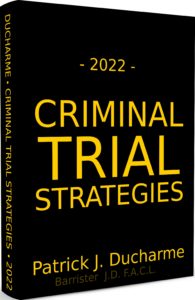Patrick Ducharme’s Criminal Trial Strategies is available at Amazon.ca or Amazon.com. For educational use, please contact MedicaLegal Publishing for a bulk discount .
Read or listen to the Preface and Introduction and subscribe to Patrick Ducharme’s Youtube Channel.
CRIMINAL TRIAL STRATEGIES
CONTENTS
PREFACE
An Urgent Call to Arms Against Tyranny 2
INTRODUCTION
The Importance of Strategy in a Criminal Trial 4
CHAPTER ONE
In The Beginning There Was Light 13
Meeting the Client: Be Interested, Stay Interested 13
Meeting the Client’s Witnesses: Be Patient, Be Supportive 15
Discovering the Case: Be Thorough, Be Relentless 21
Applying for Particulars 25
Inspecting Places and Things 26
The Trial Brief: Be Orderly, Be Complete 27
Retainer Agreements: Be Prudent, Be Defensive 28
Creating a Defence Plan 31
Finding and Instructing Experts 33
Developing a Trial Persona 37
The Power of Humility 40
Developing Strategies 41
CHAPTER TWO
Judicial Interim Release or Bail 43
Presumption of Bail 43
The Charter 44
R. v. Antic: The Right Not to be Denied Reasonable Bail 45
How Bail Works 48
Two Procedures 50
Section 469 Offences 52
Reverse Onus 55
The Importance of Disclosure 57
Disclosure Problems 58
Rules of Evidence are Different 59
Section 518 Provides Special Rules of Evidence 61
Grounds of Detention 62
History of the Tertiary Ground 63
R. v. St-Cloud and the Tertiary Ground of Bail 65
Cash Bail 68
Young Persons and Bail 69
Evidence at the Hearing 71
Adjournments 72
Non-Publication Orders 73
Recognizances and Forfeiture Proceedings 74
Sureties 75
Reviewing Bail Orders: R. v. St-Cloud 76
Alternate Ways to Review 80
CHAPTER THREE
Pre-Trial Matters 82
Introduction 82
The Procedure 86
Admission of Facts 88
Adjournments 88
Adjournments Based on Absent Witnesses 89
Decisions on Pre-Trial Applications 89
Attendance by Accused 90
Special Status of Trial Judge for Pre-Trial Applications 90
Examples of Common Pre-Trial Applications 91
Charter Applications 94
Future Charter Challenges 105
CHAPTER FOUR
Preliminary Hearings 108
Tactical Considerations 108
Purpose of a Preliminary Inquiry 110
Advantages of a Preliminary Inquiry 111
Preservation of Evidence 111
Later Use of a Transcript 112
Discovery of the Prosecution’s Case 112
Test Theories 112
Obtain Information for Charter or non-Charter Arguments 112
Advance Negotiations or Settlements 113
Other Advantages 113
Hearing Must Be Requested 113
Focus Hearings 114
Powers of the Justice 115
Role of the Justice 118
Basis of Admissibility 120
Reasonable Notice 120
“Credible or Trustworthy” Evidence 121
Right to Cross-Examine 128
Dawson Applications 129
Expert Evidence 129
Right of Accused to Call Witnesses 131
Regulating Hearing 131
Exclusion of the Public 132
Publication Bans 132
The Warning and Statement of the Accused 133
Submissions 134
The Definition of Sufficiency in 548 134
What is the Proper Method of Challenge? 137
Changing Bail 139
Preferring Indictments 140
Summary 140
CHAPTER FIVE
Criminal Trials 141
Presumption of Innocence 143
Game Plan: The Theory of Your Case 144
Criminal Procedure: The Rules of the Game 146
Criminal Law is Federal 147
Appearances in Court 148
Arraignments and Appearances 150
Failure to Appear 151
Amendments 151
Particulars 154
Joinder and Severance 155
Change of Venue 156
Law of Evidence 157
The Method and Order of Presentation of Evidence 162
Cross-Examination 164
Hearsay Evidence 168
The Co-Conspirators’ Exception to the Hearsay Rule 170
Jurisdiction of Judges 182
A View from the Bench 184
Summary of Procedural Points 186
Classification of Offences 188
CHAPTER SIX
Trial by Judge without a Jury 190
The Considerations of selecting a Judge Alone Trial In Superior Court 190
Superior Court or Provincial Court 196
Order of Presentation of Evidence 197
Order Excluding Witnesses 197
Questioning Witnesses 200
Leading Questions 201
Adverse Witnesses: and Section 9 Canada Evidence Act 202
Conclusions 205
CHAPTER SEVEN
Jury Trials 206
When Is a Jury Trial Available 206
How Will the Jury Be Selected? 206
Judge’s New Role in Jury Trials 207
Challenges for Cause 209
The Challenge for Cause Hearing 213
Absolute Jurisdiction Offences: Section 553 215
Superior Court of Criminal Jurisdiction: Section 469 There are also specified offences that must be tried in a Superior 216
Opening Addresses 218
Closing Addresses 225
CHAPTER EIGHT
Examination in Chief 235
The Art of Direct Examination 235
When it is Appropriate to Lead 235
Introducing Documentary Evidence 238
Authenticity of Documents 239
Admissibility of Documents in Possession 241
Business Records and Records from an Investigation 242
Certified Court Records 244
Prior Statements 245
Prior Consistent Statements: The Rule 246
Exceptions to the Rule 247
Hearsay Evidence: The Rule 254
Exceptions to the Rule 255
The Principled Approach to the Hearsay Rule 256
Evidentiary Issues: Hearsay Statements 266
Handwriting Identification 267
Qualified Experts 269
Sufficiently Independent or Impartial 276
CHAPTER NINE
Cross-Examination and Re-Examination 279
Effective Techniques of Cross-examination 279
Purposes 281
The Plan 284
No-Frills Questions 288
Plain Words 289
Avoiding Words and Phrases 290
Avoiding Legalese 291
Vigorous Cross-Examination 292
When Not to Cross-Examine 293
Transcripts of Prior Evidence 294
Transcripts to Remind the Witness 298
Transcripts other than Preliminary Inquiry Transcripts 301
Practical Problems 301
Police Officer’s Notes 304
Cross-Examining the Officer who is not the Enemy 305
Cross-Examining the Officer who is the Enemy 307
Cross-Examining the Expert Witness 311
A Review 323
The Possible Results of an Incomplete or Improper Cross-Examination 324
Exculpatory Evidence Should not be Excluded 333
9-21 The Rule in Browne v. Dunn 334
When the Rule Is Breached? 335
Should the Jury Be Told? 338
Re-Examination 340
CHAPTER TEN
The Art of the In-Trial Objection 346
Objections Generally 346
The Impact of Objections on the Trier 347
How to Object 349
When to Object 350
Legal Ramifications of Objections 351
Reasons to Object 353
Reasons Not to Object 354
How to Receive a Ruling on an Objection 356
What to Object to 356
Responding to Objections 361
When to be Objectionable: Civility and Collegiality 362
CHAPTER ELEVEN
Principled Persuasion 368
Techniques of Persuasion 368
Principled Persuasion 369
The Science of Human Behaviour 370
Doing the Right Thing 372
Uniqueness of Audiences 372
Ebb and Flow of a Trial: Uncertainty of Perspective 373
Bourgeois Biases 374
Working with Biases 376
Biases May Affect Jurors and Judges Differently 377
Civility But Without Fear 378
CHAPTER TWELVE
Sentencing 383
Introduction 383
The Fundamental Principle of Sentencing 387
Procedure & Rules of Evidence on Sentencing Hearings 388
Submissions by Counsel on Sentencing 390
Rules of Evidence Relaxed 391
Disputed Facts Considered Aggravating 392
Procedure for Transferring Charges within a Province 392
Offences Committed Outside of Canada 392
Minimum Mandatory Jail Sentences 394
Failing to Recognize the Consequences 395
Pardons:Now Called Record Suspensions 397
Aboriginal Offenders 397
The Fundamental Purpose of Sentencing 398
Other Sentencing Principles 399
Principles of Common Law 399
Time Spent in Custody Prior to Sentencing 401
The Old Approach 402
Discharges: s. 730 404
Suspended Sentences 405
Fines and Forfeiture 405
Victim Fine Surcharges 406
Forfeiture of Proceeds of Crime 409
Restitution 410
Prohibition Orders 411
Conditional Sentences 412
Mandatory and Optional Conditions 415
Breaches of Conditional Sentences 416
Intermittent Sentences 417
Victim Impact Statements 418
Protecting the Result on Appeal 419
Appellate Deference to Trial Judge’s Sentence 421
CHAPTER THIRTEEN
Strategies for the Media 424
Introduction 424
Ethical Considerations 424
Why Media Strategies are Necessary 429
The Power of the Media 432
The “No Comment” Technique 434
A Case Example 435
Understanding the Media 438
Entertainment: The Media’s Primary Function 442
How to Prepare for the Media – Anticipation 443
The Media as a Litigation Tool 444
The Language of the Media 445
Treatment of the Media 447
Circumstances to be Avoided 449
Conclusion 452
CHAPTER FOURTEEN
Evidentiary Issues in Drug Cases 453
The Concept of Possession 453
Knowledge 454
Control 456
The Failure of the Accused to Testify 458
Various Forms of Possession 461
Proof of Intention to Traffic 461
Prior Convictions 466
Motive to Lie 468
Continuity of Possession 469
Parties to the Offence: Section 21 of the Code 473
Proof of Identity 476
Similar Fact (Act) Evidence 478
Attempted Possession 482
Simple Possession 484
Importation 485
Sentencing 488
Conclusion 490
CHAPTER FIFTEEN
Cooperation as a Mitigating Factor on Sentence 491
Overview 491
The American Approach 492
The Canadian Approach 494
The Value to the Offender of Co-operation 495
The Reward of the Offender 495
Drug Importation Cases 502
The Presentation of Evidence of Co-operation 510
A Cautionary Note: Beware the Problems Created by the Prosecution’s Insistence on Timely Disclosure 511
Possible Problems for Defence Counsel 517
Conclusion 518
The above are the CONTENTS of Patrick Ducharme’s Criminal Trial Strategies is available at Amazon.ca or Amazon.com. For educational use, please contact MedicaLegal Publishing for a bulk discount.
Read or listen to the Preface and Introduction and subscribe to Patrick Ducharme’s Youtube Channel.

